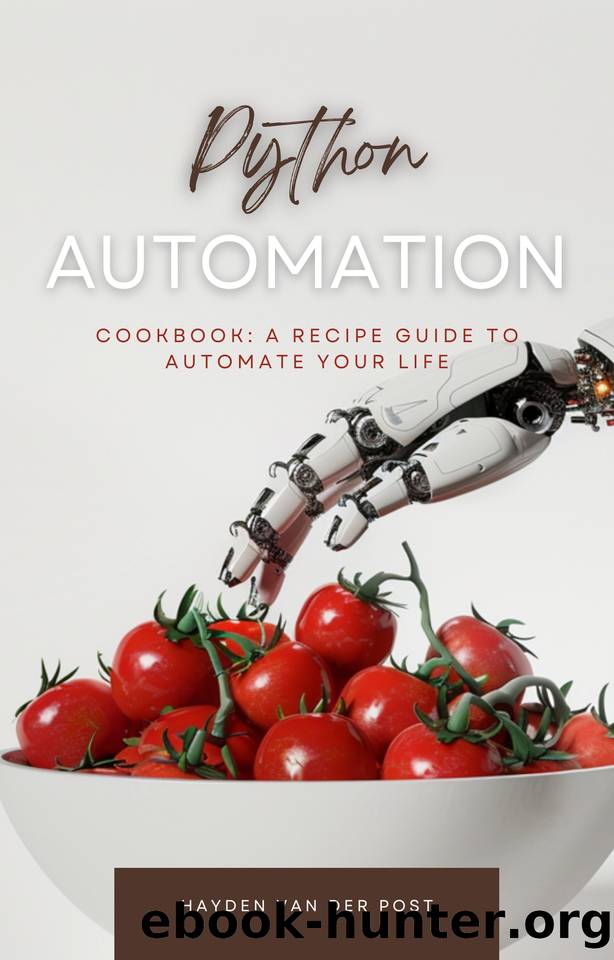The Python Automation Cookbook: A Recipe Guide to Automate your Life by Bisette Vincent & Van Der Post Hayden

Author:Bisette, Vincent & Van Der Post, Hayden
Language: eng
Format: epub
Publisher: Reactive Publishing
Published: 2024-02-24T00:00:00+00:00
Chapter 6: Data Processing and Analysis Automation
Data cleaning, the process of detecting and correcting (or removing) corrupt or inaccurate records from a dataset, forms the bedrock of high-quality data analysis. Inaccurate data can lead to faulty analytics and misguided decisions, making the cleaning process critical. Automation in data cleaning ensures consistency, saves immense time, and significantly reduces the potential for human error.
Python, with its simplicity and an extensive array of libraries, shines brightly as a tool for data cleaning. Libraries such as Pandas for data manipulation, NumPy for numerical data handling, and more specialized libraries like OpenRefine, provide a robust toolkit for automating data cleaning tasks.
Consider a dataset containing user information with inconsistencies in the formatting of phone numbers and email addresses, missing values, and duplicate records. Our goal: to automate the cleaning of this dataset.
- Step 1: Installing Necessary Libraries
Before diving into the script, ensure you have the necessary Python libraries installed. Pandas will be our primary tool, renowned for its data manipulation capabilities.
```bash
pip install pandas
```
- Step 2: Loading the Dataset
Load your dataset using Pandas. For this example, we'll assume the data is in a CSV file named `user_data.csv`.
```python
import pandas as pd
# Load the dataset
df = pd.read_csv('user_data.csv')
```
- Step 3: Identifying and Handling Missing Values
Missing values can skew your analysis and lead to incorrect conclusions. Pandas offers straightforward methods to handle these, either by filling them with a default value or removing rows/columns containing them.
```python
# Fill missing values with a placeholder
df.fillna('Unknown', inplace=True)
# Alternatively, to remove rows with missing values
# df.dropna(inplace=True)
```
- Step 4: Standardizing and Correcting Data
Inconsistencies in data formatting can complicate analysis. For phone numbers and email addresses, we'll standardize the format and correct obvious errors.
```python
# Standardize phone number format
df['phone'] = df['phone'].str.replace(r'\D', '') # Removes non-numeric characters
df['phone'] = df['phone'].apply(lambda x: f"+1{x}" if len(x) == 10 else x)
# Simple email format correction (example)
df['email'] = df['email'].str.lower() # Ensures all emails are in lowercase
```
- Step 5: Removing Duplicate Records
Duplicates can distort data analysis. Pandas' `drop_duplicates` method comes to the rescue.
```python
df.drop_duplicates(inplace=True)
```
- Step 6: Exporting the Cleaned Dataset
After cleaning, export the dataset back to a CSV file, ready for analysis.
```python
df.to_csv('cleaned_user_data.csv', index=False)
```
While the steps above cover basic cleaning, more complex scenarios may require advanced techniques like regular expressions for pattern matching, fuzzy matching libraries for approximate string matching, and even machine learning models to predict and correct values.
Automating data cleaning tasks with Python not only elevates the quality of your data analysis but also allows you to allocate valuable time to more strategic tasks. As we continue to advance through "The Python Automation Cookbook," the proficiency gained in cleaning data sets a foundation for more sophisticated data manipulation and analysis techniques, ensuring that the insights derived are as accurate and valuable as possible.
0Need for Data Cleaning in Data Analysis
data analysis seeks to distill clarity and insights from raw data. However, this raw data, much like uncut gemstones, often comes embedded with impurities and flaws. Herein lies the essence of data cleaning: a meticulous process of detecting, diagnosing, and rectifying inaccuracies or imperfections in data. The process
Download
This site does not store any files on its server. We only index and link to content provided by other sites. Please contact the content providers to delete copyright contents if any and email us, we'll remove relevant links or contents immediately.
Deep Learning with Python by François Chollet(12881)
A Developer's Guide to Building Resilient Cloud Applications with Azure by Hamida Rebai Trabelsi(10210)
Hello! Python by Anthony Briggs(10131)
The Mikado Method by Ola Ellnestam Daniel Brolund(10020)
OCA Java SE 8 Programmer I Certification Guide by Mala Gupta(9988)
Dependency Injection in .NET by Mark Seemann(9524)
Hit Refresh by Satya Nadella(9001)
Algorithms of the Intelligent Web by Haralambos Marmanis;Dmitry Babenko(8532)
The Kubernetes Operator Framework Book by Michael Dame(8273)
Exploring Deepfakes by Bryan Lyon and Matt Tora(8061)
Practical Computer Architecture with Python and ARM by Alan Clements(8007)
Implementing Enterprise Observability for Success by Manisha Agrawal and Karun Krishnannair(7986)
Robo-Advisor with Python by Aki Ranin(7980)
Sass and Compass in Action by Wynn Netherland Nathan Weizenbaum Chris Eppstein Brandon Mathis(7921)
Grails in Action by Glen Smith Peter Ledbrook(7891)
Building Low Latency Applications with C++ by Sourav Ghosh(7870)
Svelte with Test-Driven Development by Daniel Irvine(7863)
Test-Driven iOS Development with Swift 4 by Dominik Hauser(7858)
Becoming a Dynamics 365 Finance and Supply Chain Solution Architect by Brent Dawson(7780)
